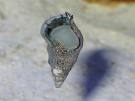Cerith Snail - Cerithium sp.
Cerith snails are small reef-safe snails known for their hardiness and ease of care. Cerithium speciescan be found all around the world,but most of the snails in aquarium trade originate from the Caribbean Sea, the sea of Cortez and other waters near and around the United States.The size of the species commonly available in the aquarium trade varies from less than an inch (<2.5 cm) to close to two inches (<5 cm). Cerith snails have pointy shells and are usually dark to black or tan in color. They are known to be very long lived.
Cerith snails are among the hardiest of all animals commonly kept in marine aquariums and are, once established in the tank, very easy to care for. Like all molluscs these snails should be acclimatized slowly through drip acclimatization when moved to a new tank. Allow at least 2 hours for acclimatization. Although being hardy, Cerith snails are intolerant to copper and high nitrate levels (over 20). They prefer a specific gravity of 1.023 - 1.025, pH 8.1 - 8.4 and a temperature of 72-78° F / 22-25° C. They do best in aquariums with a lot of live rock and a deep sand bed.
Cerith snails are ideal for reef aquariums as they will not harm the residents or disturb the landscaping. They do a lot of good in reef setups as they are scavengers that will eat any uneaten food, fish waste, and detritus as well as algae. Some but not all Cerith snails eat hair and film algae. Their preferred food source is algae and if there are enough algae in the aquarium they will eat exclusively algae. If the aquarium has little algae the snails need to be fed supplement food, such as dried sea weed rapped around a rock or otherwise fixated on the bottom of the tank. They are best fed at night as they are primarily active during the night even if they can be out and about in the daytime as well. They will burrow through the sand in search of food and a safe place to sleep; thereby making sure no oxygen depleted areas are created in the bottom substrate. They are among the only snails that will eat algae growing on the glass beneath the sand bed
Cerith snails can usually be bought in aquarium stores that sell saltwater fish and supplies, including web shops. A Cerith snail usually costs between $ 1-2. They can also be introduced to your aquarium with live rock.
Breeding Cerith snails
Cerith snails can be bred in aquariums but quite a few aquarists consider them difficult to breed. They do however breed spontaneously in many marine tanks and can quickly increase in numbers. A lot of algae in the aquarium can help trigger these snails to spawn, and so can an increase in water temperature. The egg clusters look like twisted phone wires. They young snails grow rapidly and a lot of calcium is needed for proper shell development; it is therefore important to make sure that there is a lot of available calcium in the water. The young snails prefer calm areas without any current.Examples of common Cerith snail species
Cerithium litertatum (Stocky Cerith, True Cerith): This species is the hardiest of all the species and is very common in the trade. It grows to be about 1.75 in (4.3 cm).
Cerithium altratum: This species is hardy and does very well in marine reef aquariums. It is strictly herbivorous.

